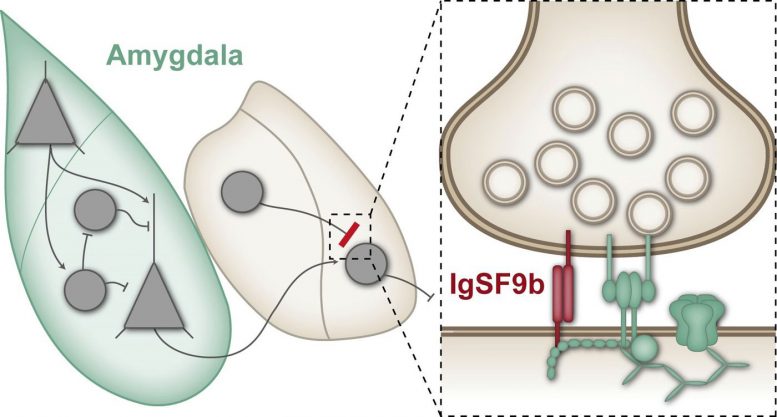
The IgSF9b protein connects inhibitory neurons in the centromedial amygdala (left, grey area). This brain area is involved in anxiety regulation. © MPI f. Experimental Medicine/ Krüger-Burg
Anxiety disorders are severe mental disorders in which patients suffer from intense fears and anxiety or from sudden, inexplicable panic attacks. In extreme cases, the affected individuals rarely leave their homes, which can have serious consequences for their relationships with family and friends as well as for their professional lives. Scientists at the Max Planck Institute for Experimental Medicine in Göttingen have now identified a synaptic protein which, when inactivated, has an anxiolytic effect in mice.
Around ten percent of the population suffer from anxiety disorders, and current treatment options only offer effective help for a proportion of those affected. One of the changes observed in the brains of patients with anxiety disorders is an increased neuronal activity in the amygdala, a brain region that plays a key role in processing emotions such as anxiety or fear. An overactivation of the amygdala is thought to be involved in causing exaggerated anxiety. Many anxiolytic medications such as benzodiazepines presumably normalize this overactivation by strengthening the function of inhibitory synapses.
Synapses are connections between nerve cells in the brain, at which information is transmitted from one nerve cell to another. At inhibitory synapses, this transmission results in a reduction in the activity of the neighboring nerve cells. In the amygdala, for instance, this inhibits the transmission of stimuli that trigger fear and anxiety. Benzodiazepines strengthen this inhibitory effect – but unfortunately, they affect not only those inhibitory synapses that transmit anxiogenic stimuli but also many other inhibitory synapses in the brain. This can lead to significant side effects such as pronounced sedation and impaired concentration. Accordingly, scientists are searching for new, more specific targets for anxiolytic medications.
Mice with anxiety disorder
Animal research with mice played a key role in helping the researchers in Göttingen to study anxiety disorders. Whereas healthy animals curiously investigate an empty test chamber, rodents with a pathological anxiety phenotype withdraw into a corner because they are afraid. However, when the scientists blocked the production of the recently discovered protein IgSF9b in these mice, the animals moved freely around the chamber again. IgSF9b produces a protein bridge at inhibitory synapses between two neighboring nerve cells. “Blocking IgSF9b in pathologically anxious mice has an anxiolytic effect and normalizes anxiety behavior in these animals. This protein could therefore be a target for pharmacological approaches to treating anxiety disorders,” explains Olga Babaev from the Max Planck Institute for Experimental Medicine who carried out the experiments as part of her doctoral work..
An investigation of the amygdala in these animals revealed that the overactivation of the amygdala was normalized, and that this effect resulted from a strengthening of the synaptic transmission at inhibitory synapses in the amygdala. “Our research shows that protein structures at inhibitory synapses in the centromedial amygdala, and particularly the protein IgSF9b, constitute promising new targets for potential treatments. It thus provides an important contribution toward understanding the biological causes of anxiety disorders and for the development of new anxiolytic medications,” study leader Dilja Krueger-Burg says.
Reference: “IgSF9b regulates anxiety behaviors through effects on centromedial amygdala inhibitory synapses” by Olga Babaev, Hugo Cruces-Solis, Carolina Piletti Chatain, Matthieu Hammer, Sally Wenger, Heba Ali, Nikolaos Karalis, Livia de Hoz, Oliver M. Schlüter, Yuchio Yanagawa, Hannelore Ehrenreich, Holger Taschenberger, Nils Brose and Dilja Krueger-Burg, 20 December 2018, Nature Communications volume 9, Article number: 5400 (2018).
DOI: 10.1038/s41467-018-07762-1


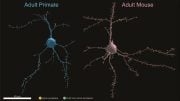
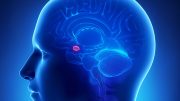
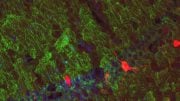
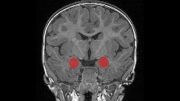


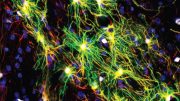
What a conundrum this is. We search so hard for medications that help people then stigmatize and demonize the individual for using it. Yes Benzo’s help just like opioids help with pain. If you use them society can’t handle it. Geez!
Could someone tell me what happened with Emapunil?